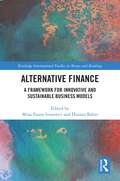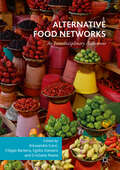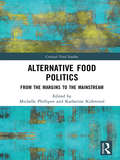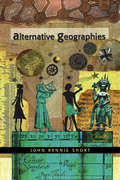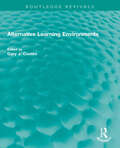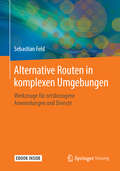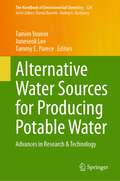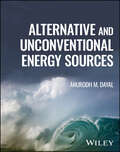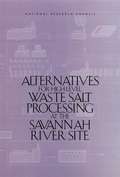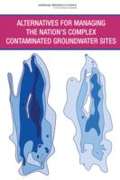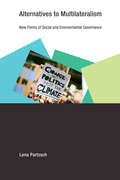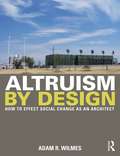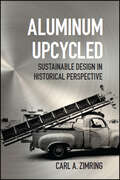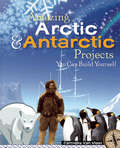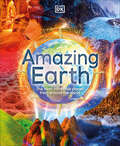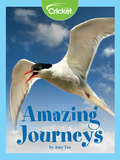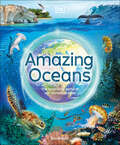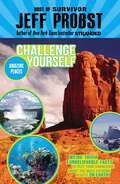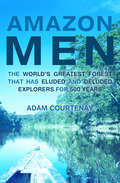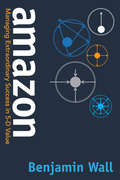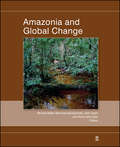- Table View
- List View
Alternative Finance: A Framework for Innovative and Sustainable Business Models (Routledge International Studies in Money and Banking)
by Mina Fanea-Ivanovici Hasnan BaberThe alternative financing space has grown exponentially in the last few decades, namely as a consequence of the financial crisis, technological advancement, niche customer segments, and more recently the pandemic. Now, with the inclusion of Fintech, online lenders, crowdfunding, accelerators, venture capitalists, or angel investors, this funding channel is no longer seen as a substitute for formal financing, but rather a core one. This book is a comprehensive guide to alternative financing methods, offering insights into emerging trends, the role of FinTech, and the intersection of finance with sustainability, innovation, and entrepreneurship.It fills a knowledge gap by exploring innovative financing channels such as fintech, green finance, and venture capital as well as other non-traditional ways of raising funds, which have become crucial for startups and businesses. It discusses the impact of financial technology (FinTech) on these methods and their function in supporting entrepreneurship and sustainable business, while also examining the implications of these technological advancements in the wider financial sector. It addresses challenges and opportunities for entrepreneurs and explores how alternative financing options can support growth and innovation, particularly in the context of environmentally and socially focused ventures, including how to integrate economic, social, and environmental considerations. The emphasis on sustainability and green finance aligns with the growing global concern for responsible business practices and the Sustainable Development Goals.While the primary audience for the book is scholars, researchers, and students, the inclusion of case studies, and the exploration of various financing options, extends practical cues for policymakers and practitioners and contributes to the understanding of how finance, entrepreneurship, and sustainability intersect in real-world business scenarios.
Alternative Food Networks: An Interdisciplinary Assessment
by Alessandro Corsi Filippo Barbera Egidio Dansero Cristiana PeanoIn recent years, Alternative Food Networks (AFNs) have been a key issue both in the scientific community and in public debates. This is due to their profound implications for rural development, local sustainability, and bio-economics. This edited collection discusses what the main determinants of the participation of operators – both consumers and producers – in AFNs are, what the conditions for their sustainability are, what their social and environmental effects are, and how they are distributed geographically. Further discussions include the effect of AFNs in structuring the food chain and how AFNs can be successfully scaled up.The authors explicitly take an interdisciplinary approach to analyse AFNs from different perspectives, using as an example the Italian region of Piedmont, a particularly interesting case study due to the diffusion of AFNs in the area, as well as due to the fact that it was in this region that the ‘Slow Food’ movement originated.
Alternative Food Politics: From the Margins to the Mainstream (Critical Food Studies)
by Michelle Phillipov Katherine KirkwoodMedia interest in food has intensified in recent years, leading to a contemporary food landscape where ‘alternative’ food practices are increasingly visible. Concerns that were once exclusively the domain of activist movements motivated by environmental, animal rights, health and anti-corporate agendas are now central to primetime television cooking shows, mobile apps and social media. This book is the first to explore the impact of popular media and culture on contemporary food politics. Through examination of a range of media and cultural texts, including news, digital media, advertising and food labelling, it brings together leading and emerging scholars in food studies, media and communications, sociology, law, policy studies, business, and geography. The book explores the practices of alternative food movements, the marketing techniques of conventional and alternative food producers, and the relationships between food industries, media, and the public. Covering topics ranging from agtech start-ups and social justice projects, to new ways of mediating food waste, celebrity, and ‘ethical’ foods, Alternative Food Politics reveals the importance of media as a driver of food system transformation. This is a pivotal time for media and food industries, and this book is essential reading for scholars and students seeking to better understand the futures, possibilities and limits of food politics today.
Alternative Fuels for Environmentally-Friendly Ships: Hydrogen, Ammonia, Bio-fuels and E-fuels (SpringerBriefs in Applied Sciences and Technology)
by Youngsub LimThis book reports on current shipping and shipbuilding industries' efforts for decarbonization. It demonstrates what regulations have been made for large ships on international voyages and points to what is to change in the future. The book also quantitatively reviews the current challenges of alternative fuels such as hydrogen, ammonia, biofuels, and e-fuels, considering economics, safety, and greenhouse gas emissions assessments.
Alternative Geographies
by John Rennie ShortAn accessible and groundbreaking text that takes a fresh view of contemporary geographical issues by looking at the geographies we have lost.Geography means writing about the world. Alternative ways of writing about the world are introduced and critically evaluated. The book discusses medieval cosmologies, Renaissance magic, feng shui, and the knowledge systems of indigenous people. Alternative Geographies provides an alternative way of looking, describing and understanding the world
Alternative Learning Environments (Routledge Revivals)
by Gary J. CoatesOriginally published in 1974, this volume presents viable alternatives to traditional attitudes and practices in environmental design and education. It contains 29 selections that reflect the thought and actions of leaders from many diverse disciplines and professions. Architects, landscape architects, urban planners, teachers and administrators, psychologists and social theorists address themselves to controversial and important issues facing our post-industrial society. The range of subjects explored in the volume is far-reaching: • Environmental education in which the art of planning and designing itself becomes the curriculum • Advocacy planning and community participation in bo9th educational and design decision making • Alternative educational institutions, ranging from community-centered schools and mobile schools to non-school learning networks that distribute the learning activity throughout the fabric of the city and the lifetime of the learner. • New developments in systematic design methods and evaluation research that promise to make the design process more public and responsive to the user-client.
Alternative Planning History and Theory
by Dorina PojaniThis book includes twelve carefully commissioned chapters each of which presents an alternative planning history and theory written from the perspective of groups that have been historically marginalized or neglected. In teaching planning history and theory, many planning programs tend to follow the planning cannon - a normative perspective that mostly accounts for the experience of white, Anglo, Christian, middle class, middle aged, heterosexual, able-bodied, men. This book takes a unique approach. It provides alternative planning history and theory timelines for each of the following groups: women, the poor, LGBTQ+ communities, people with disabilities, older adults, children, religious minorities, people of color, migrants, Indigenous people, and colonized peoples (in South Asia and Sub-Saharan Anglophone Africa). To allow for easy cross-comparison, chapters follow a similar chronological structure, which extends from the late 19th century into the present. The authors provide insights into the core planning issues in each time period, and review the different stances and critiques. The book is a must-read for planning students and instructors. Each chapter includes the following pedagogical features: (1) a boxed case study which presents a recent example of positive change to showcase theory in practice; (2) a table which lays out an alternative planning history and theory timeline for the group covered in the chapter; and (3) suggestions for further study comprising non-academic sources such as books, websites, and films.
Alternative Routen in komplexen Umgebungen: Werkzeuge für ortsbezogene Anwendungen und Dienste
by Sebastian FeldDas Buch zeigt verschiedene Ansätze und Verfahren, um alternative Routen in Freiflächen zu berechnen, geospatiale Trajektorien zu vergleichen sowie Strukturen in Gebäuden zu identifizieren. Die Wegefindung in komplexen Umgebungen unterscheidet sich von der in Straßennetzen vor allem dadurch, dass sich eine Person nahezu in alle Richtungen bewegen kann. Das Vorhalten von alternativen Routen für Fußgänger (aber auch für mobile Roboter) in Flughäfen, Krankenhäusern, Messehallen, Parks, Industrieanlagen oder Lagerhallen ermöglicht beispielsweise eine personalisierte Navigation, sodass proaktiv Stau vermieden oder blockierten Bereichen ausgewichen wird.Im ersten Teil des Buches definiert der Autor alternative Routen in komplexen Umgebungen, stellt den Algorithmus zum Berechnen solcher Routen vor und geht auf Qualitätsmetriken sowie Alternativgraphen ein. Im zweiten Teil legt Sebastian Feld unter anderem ein System zum Vergleich von Routen vor, mit dem aus einer Menge von Routen die extremsten Exemplare extrahiert werden können. Schließlich integriert er im dritten Teil des Buches die quantitative Analyse der visuellen Wahrnehmung von Raum in den Kontext alternativer Routen. Damit bietet das Buch einen Werkzeugkasten, der von weiteren ortsbezogenen Anwendungen und Diensten verwendet werden kann.
Alternative Water Sources for Producing Potable Water: Advances in Research & Technology (The Handbook of Environmental Chemistry #124)
by Tamim Younos Tammy E. Parece Juneseok LeeDuring the third decade of the 21st century, communities across the world are being challenged with water scarcity both in rural and urban areas. Another significant problem is the energy demand for producing potable water. Our recent book “Resilient Water Management Strategies in Urban Settings: Innovations in Decentralized Water Infrastructure Systems” (Springer; 2022) introduced various facets of decentralized water infrastructure and the significant need for a shift toward using locally available alternative water sources. The proposed volume will expand on the concept and use of alternative water sources; rainwater, stormwater, wastewater/greywater, saline waters, and atmospheric water. Use of alternative water sources for potable purposes is a critical emerging research and technology area. In our knowledge such a book does not exist at this time. This volume will be a significant resource for researchers and graduate level teaching, and serve as a roadmap for water resource engineers and planners tackling water scarcity and diverse water resources portfolios.
Alternative and Unconventional Energy Sources
by Anurodh M. DayalA timely volume for understanding our future energy landscape and for creating a bridge towards a decarbonized energy system Alternative and Unconventional Energy Sources discusses various alternative energy sources and their present usage, including wind, solar, ocean, and geothermal energy, along with unconventional fossil energy sources, such as shale gas. The text covers the development and global adoption of each energy source, along with their environmental and economic impacts, resulting in a comprehensive and in-depth treatment of the subject. This approach provides the reader with a one-stop reference for each particular energy source, making the information accessible to all, regardless of discipline or current level of experience with each energy source. Specific topics covered in Alternative and Unconventional Energy Sources include: The controversial perception of shale gas and its future potential as an energy source Technologies to reduce harmful emissions of CO2 and other waste gases and their potential to cause less global warming Downsides of commonly accepted alternative energy sources, such as the disposal of nuclear waste and land requirements for solar panels How undeveloped countries can make use of local energy sources to become more efficient and competitiveAlternative and Unconventional Energy Sources is a highly accessible and useful resource for geographers, geologists, petroleum engineers, renewable energy specialists, and policy makers who wish to understand the current state of global energy production and where the industry may turn in the coming years.
Alternatives For High-level Waste Salt Processing At The Savannah River Site
by National Research CouncilAt the request of the US Department of Energy, the Committee provides a technical review of alternatives selected by representatives of the South Carolina site for processing the high-level radioactive waste salt solutions stored there in 48 below-grade tanks. Annotation c. Book News, Inc. , Portland, OR (booknews. com)
Alternatives for Managing the Nation's Complex Contaminated Groundwater Sites
by Robert J. KattAcross the United States, thousands of hazardous waste sites are contaminated with chemicals that prevent the underlying groundwater from meeting drinking water standards. <P><P>These include Superfund sites and other facilities that handle and dispose of hazardous waste, active and inactive dry cleaners, and leaking underground storage tanks; many are at federal facilities such as military installations. While many sites have been closed over the past 30 years through cleanup programs run by the U.S. Department of Defense, the U.S. EPA, and other state and federal agencies, the remaining caseload is much more difficult to address because the nature of the contamination and subsurface conditions make it difficult to achieve drinking water standards in the affected groundwater.
Alternatives to Multilateralism: New Forms of Social and Environmental Governance (Earth System Governance)
by Lena PartzschAnalysis and case studies of emerging forms of private, public, and hybrid social and environmental governance.The effects of globalization on governance are complex and uncertain. As markets integrate, governments have become increasingly hesitant to enforce regulations inside their own jurisdictions. At the same time, multilateralism has proven unsuccessful in coordinating states' responses to global challenges. In this book, Lena Partzsch describes alternatives to multilateralism, offering analyses and case studies of emerging--alternative--forms of private, public, and hybrid social and environmental regulation. In doing so, she offers a unique overview of cutting-edge approaches to global governance.
Altruism by Design: How To Effect Social Change as an Architect
by Adam R. WilmesAltruism by Design: How to Effect Social Change as an Architect is meant to prepare the individual designer – whether a student or practicing professional – for a career dedicated to serving communities in need through design and construction. It will help you understand the complexities, opportunities, and benefits of creating architecture that promotes social equality and community so that you can make a difference. What you'll learn: -How community-based studios can respond to natural disasters and economic conditions-How to build what you design-How to develop relationships with non-traditional clients-How to structure your career to be dedicated to social change and sustainable design-How to discover funding opportunities for projects in a not-for-profit firm-How to consider moral and financial aspects of your practice-How you can collaborate with other design professions to determine the future of the built environment Featuring detailed case studies, including work by Studio 804 and Pyotak Architects, and more than 100 color images; this book is essential reading for providing you with a viable path to altruistic design.
Aluminum Upcycled: Sustainable Design in Historical Perspective (Johns Hopkins Studies in the History of Technology)
by Carl A. ZimringTracing the benefits—and limitations—of repurposing aluminum.Besides being the right thing to do for Mother Earth, recycling can also make money—particularly when it comes to upcycling, a zero waste practice where discarded materials are fashioned into goods of greater economic or cultural value. In Upcycling Aluminum, Carl A. Zimring explores how the metal’s abundance after World War II—coupled with the significant economic and environmental costs of smelting it from bauxite ore—led to the industrial production of valuable durable goods from salvaged aluminum. Beginning in 1886 with the discovery of how to mass produce aluminum, the book examines the essential part the metal played in early aviation and the world wars, as well as the troubling expansion of aluminum as a material of mass disposal. Recognizing that scrap aluminum was as good as virgin material and much more affordable than newly engineered metal, designers in the postwar era used aluminum to manufacture highly prized artifacts. Zimring takes us on a tour of post-1940s design, examining the use of aluminum in cars, trucks, airplanes, furniture, and musical instruments from 1945 to 2015. By viewing upcycling through the lens of one material, Zimring deepens our understanding of the history of recycling in industrial society. He also provides a historical perspective on contemporary sustainable design practices. Along the way, he challenges common assumptions about upcycling’s merits and adds a new dimension to recycling as a form of environmental absolution for the waste-related sins of the modern world. Raising fascinating questions of consumption, environment, and desire, Upcycling Aluminum is for anyone interested in industrial and environmental history, discard studies, engineering, product design, music history, or antiques.
Amadera Prithibi (Our World) class 6 - West Bengal Board: আমাদের পৃথিবী ষষ্ঠ শ্রেণি
by West Bengal Board of Secondary Educationআমাদের পৃথিবী বইটি পশ্চিমবঙ্গ মধ্যশিক্ষা পর্ষদের ষষ্ঠ শ্রেণির ভূগোল পাঠ্যপুস্তক। এটি ভূগোল ও পরিবেশবিদ্যার এক আকর্ষণীয় ও সহজবোধ্য পরিচিতি প্রদান করে, যা জাতীয় পাঠক্রমের রূপরেখা ২০০৫ এবং শিক্ষার অধিকার আইন ২০০৯-এর সঙ্গে সামঞ্জস্যপূর্ণ। বইটিতে সৌরজগৎ, পৃথিবীর গঠন ও গতি, মহাদেশ ও মহাসাগর, জলবায়ু, দূষণ এবং ভারতের ভৌগোলিক ও সাংস্কৃতিক বৈচিত্র্যের মতো বিষয়গুলি অন্তর্ভুক্ত করা হয়েছে। সহজ ভাষা, ছবি, মানচিত্র ও কার্যক্রমের মাধ্যমে ভূগোলকে শিক্ষার্থীদের কাছে আকর্ষণীয় ও বোধগম্য করে তোলা হয়েছে। হাতে-কলমে অনুশীলন ও চিত্রিত ধারণার মাধ্যমে পাঠ্যক্রমকে অভিজ্ঞতামূলক শেখার দিকে পরিচালিত করা হয়েছে। বইটি মানবজীবন ও পরিবেশের আন্তঃসংযোগকে তুলে ধরে এবং শিক্ষার্থীদের কৌতূহল ও বিশ্লেষণ ক্ষমতা বৃদ্ধিতে সহায়তা করে।
Amazing Arctic and Antarctic Projects
by Steven Weinberg Carmella Van VleetAmazing Arctic & Antarctic Projects You Can Build Yourself explores the Earth's polar regions with 25 interactive projects, activities, and experiments. Kids ages 9 and up will discover that the coldest places on Earth hold fascinating scientific wonders and mysteries. Historical facts and anecdotes, biographies, and fascinating trivia support the fun projects to teach young readers about the harsh polar climate, immense Arctic tundra, magical Northern Lights, vast glaciers, ancient frozen lakes, remarkable animals and plants, brave explorers, innovative people who live and work at the top and bottom of the world, and the vital importance of conservation. With Amazing Arctic & Antarctic Projects You Can Build Yourself kids will gain an appreciation for the exciting and extraordinary polar environments.
Amazing Earth: The Most Incredible Places From Around The World (DK Amazing Earth)
by Anita Ganeri DKAn exhilarating guided tour around the most amazing places on Earth, perfect for young adventurers with big imaginations! Award-winning children&’s author Anita Ganeri takes curious kids who love learning to the most incredible locations in the world. This science book for kids includes breathtaking images and mind-blowing facts about our majestic home — Earth! Turn the pages to discover natural wonders, stunning vistas and other jaw-dropping places from around the world. Inside the pages of this book about Earth, you&’ll discover: • Over 100 far-flung locations around the globe with areas so incredible you&’ll barely be able to believe they are real! • Illustrations that explain key natural phenomena and reveal exciting, in-depth details about some of the locations you&’ll explore. • A world map showing all the places together, and locator maps show where each site is in the world. • A foreword by Steve Backshall MBE – BAFTA and Emmy-winning English naturalist, explorer, philanthropist, author, and television presenterMount Everest and the Eiffel Tower are two of the most famous places to see on earth, but what if we told you our planet has more to offer? From waterfalls that look like they are on fire to a cave filled with twinkling blue glow worms and a bright pink lake, explore the most unbelievable, unusual and incredible places on Earth! Beautiful, dazzling images and information explores why each place is unique. Delve into the science, geology, flora and fauna, as well as the historical or cultural significance of each of these natural wonders! It is perfect for children age 7 to cultivate a lifelong curiosity about the natural sciences and the wonders of the world around them.
Amazing Journeys
by Amy TaoWhy do some animals migrate? In this story, readers will learn about the journeys of animals to find more food or to seek better weather. Six animals—a wildebeest, bat, tern, godwit, dragonfly, and penguin—describe what makes their migrations amazing.
Amazing Oceans: The Surprising World of Our Incredible Seas (DK Amazing Earth)
by Annie RothGo on an underwater adventure in this detailed look at our oceans&’ most fascinating places, plants and animals.This fascinating book will take children beyond the seaweed, sharks, and shells that you have seen many times before, and show you the secret world that lies in and around our amazing oceans. This ocean book for children aged 7-9 delves into facts about our marine environments that most people don&’t know. Dive into the deepest sea trench ever discovered, marvel at immortal anemones, and learn how devastating water tornadoes form. Kids can ponder at a whole range of topics, from unique ocean habitats, newly-discovered creatures, marine mysteries, and the exciting world of ocean exploration.This educational ocean book for kids offers: Enticing information on the most incredible ocean features, explaining how they work, why they are unusual, and what is amazing about them.Detailed diagrams, maps and charts that bring the beauty, science or geography of each topic to life.Spectacular photography, including incredible satellite images and mind-boggling microscope photos, to maximize the impact of each topic.Have you ever wondered how big the oceans actually are? Or how animals communicate in the water? Or how plants are able to grow in the sea? This book answers those questions, and many, many more. Amazing Oceans is the ideal book for inquisitive kids aged 7 and above, and especially those with a passion for wildlife, science, or geography. With in-depth information, vivid photographs and illustrations, children can get to know the most incredible environments on Earth.
Amazing Places: Weird trivia and unbelievable facts to test your knowledge about the most extreme places on earth! (Challenge Yourself #2)
by Jeff ProbstCHALLENGE YOURSELF! A new nature-based trivia series with vibrant visuals and fascinating facts! Discover the most incredible natural wonders and extreme places on earth! New from Emmy-Award winning host of Survivor and New York Times bestselling author of Stranded, Jeff Probst comes a dynamic and graphic line of trivia books! Packed with full-color photos, fascinating facts and trivia, and great callouts from Jeff, this series is perfect for every kid looking to know the coolest, weirdest facts and trivia around! Challenge yourself to discover the world&’s most extreme places! From the driest desert to the deepest ocean trench and everything in between, find out all the fascinating facts about the land, sea, and air.
Amazon Adventure: How Tiny Fish Are Saving the World's Largest Rainforest
by Sy Montgomery Keith Ellenbogen<P>Considered the “lungs of the world,” the Amazon provides a full fifth of the world’s oxygen, and every year unsustainable human practices destroy 2.7 million acres. What can be done to help? That’s where Project Piaba comes in. <P>Join the award-winning author Sy Montgomery and the photographer Keith Ellenbogen as they traverse the river and rainforest to discover how tiny fish, called piabas, can help preserve the Amazon, its animals, and the rich legacy of its people. Amazon Adventure is an eye-opening—and ultimately hopeful—exploration of how humanity’s practices are affecting and shaping not only the Amazon, but our entire environment. <P><B>Winner of the 2018 Riverby Award</b>
Amazon Men: The World's Greatest Forest that Has Eluded and Deluded Explorers for 500 Years
by Adam Courtenay“Captivating . . . An examination of complex and contradictory human responses to the development of the Amazon and to its preservation” (The Australian). Amazon Men is about conquistadors and botanists, colonizers and human rights activists, slave traders and philanthropists—that is, people who have variously tried to conquer, rework, map, enslave, and save this region and its river system, each according to the needs and zeitgeist of their time in history. The environmental battles of today are part of a long-running story that’s been going on since Europeans first discovered this impenetrable ocean of green. For centuries there’s been a war of attrition between the greatest ecosystem and the greatest predator. Up until now, the predator has failed. Amazon Men is about those who’ve tried to conquer and exploit the Amazon—and those who’ve tried to understand and savor it. Conquistadors Francisco de Orellana and Lope de Aguirre play their parts as representatives of the Age of Discovery. Charles Marie de La Condamine is a perfect foil for the Age of Enlightenment. Alexander von Humboldt appears as a scientist of the Romantic age, seeking unity in the midst of chaos. Walter Hardenburg represents the machine age, defying the industrial imperatives of his time to oppose unfettered colonial capitalism. Sydney Possuelo, the greatest living Amazonian explorer, represents the ongoing conflict between modern expansion and environmental causes. What do their experiences tell us about our attitude to the unexplored and unknown? The stories of Amazon Men recount deeds of bravery and acts of brilliance, but also forgotten holocausts where guns, germs, and steel have all played their roles.
Amazon: Managing Extraordinary Success in 5-D Value
by Benjamin WallIn Amazon: Managing Extraordinary Success in 5-D Value, Benjamin Wall offers structured insights into strategically managing value in the key relationships to customers, personnel, business partners, and investors in order to improve value management at any company.The extraordinary success of Amazon is due to market-leading strength in three &“dimensions&” of value: owning the mightiest supply chain to deliver fastest and cheapest the broadest range of products, enhancing what customers and business partners are doing when using the website / online ecosystem, and knowing how to implement the optimal terms and conditions in the after-sales customer experience. Wall takes a look at the unique managerial skill of Amazon and how each of these organizational areas operates externally and internally according to a separate business logic based on a dimension of value.In an original examination, Wall systematically evaluates Amazon by categorizing and connecting its external and internal success factors to dimensions of value. Each &“score&” on an external success factor is linked to an internal success factor in managing processes, organizational culture, and the business model, so that managers and leaders can enhance their own internal success factors and move towards the same successful external factors. Amazon looks to the future where the near-term promise of the company is evaluated to be in the development from online to omnichannel retail, including the sale of services, by reviving out of Amazon&’s past the fourth dimension of value: feeling how to integrate value. The long-term potential of Amazon is set in the context of a sustainable future for retail, based on trends arising today in meaning across multiple communities, which is the emerging fifth dimension of value. Amazon is projected to operate in this value dimension again as a disruptor, and with Wall&’s help, managers and leaders can reach for the same kind of success.
Amazonia and Global Change
by Pedro Silva Dias Mercedes Bustamante John Gash Michael KellerPublished by the American Geophysical Union as part of the Geophysical Monograph Series, Volume 186.Amazonia and Global Change synthesizes results of the Large-Scale Biosphere-Atmosphere Experiment in Amazonia (LBA) for scientists and students of Earth system science and global environmental change. LBA, led by Brazil, asks how Amazonia currently functions in the global climate and biogeochemical systems and how the functioning of Amazonia will respond to the combined pressures of climate and land use change, such asWet season and dry season aerosol concentrations and their effects on diffuse radiation and photosynthesisIncreasing greenhouse gas concentration, deforestation, widespread biomass burning and changes in the Amazonian water cycleDrought effects and simulated drought through rainfall exclusion experimentsThe net flux of carbon between Amazonia and the atmosphereFloodplains as an important regulator of the basin carbon balance including serving as a major source of methane to the troposphereThe impact of the likely increased profitability of cattle ranching.The book will serve a broad community of scientists and policy makers interested in global change and environmental issues with high-quality scientific syntheses accessible to nonspecialists in a wide community of social scientists, ecologists, atmospheric chemists, climatologists, and hydrologists.
